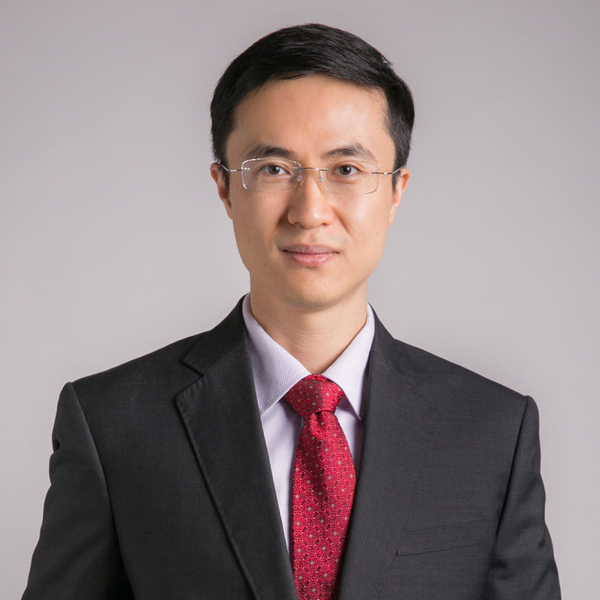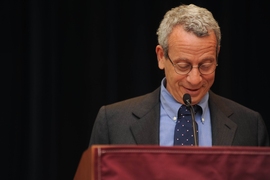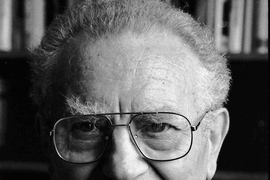Both sections of MIT class 15.433 (Financial Markets), taught this fall by visiting associate professor of finance Hong Ru MFin ’10, PhD ’15 at the MIT Sloan School of Management, include over 100 students from the master of finance program. However, when he joined the program’s inaugural class just over a decade ago, this number was much smaller.
“I started in the program in 2009 and graduated in 2010, and there were only 26 students then. Not like today,” says Ru, who is an associate professor of banking and finance at Nanyang Business School. Along with his wife, Juno Wei Chen MFin ’10, Ru returned to Boston after eight years in Singapore to teach the next generation of MFin students at MIT Sloan.
Chen, a senior portfolio manager of the Global Asset Allocation team at Columbia Threadneedle Investments, says their return to Boston and MIT Sloan has been a “great pleasure.” It’s where they first met, where they started their careers in academia and finance, and where they got married.
Ru is especially grateful for the chance to give back to the program that introduced him to Chen and set the pair on their respective career paths, going as far as to describe it as the duty of alumni.
“It’s not just my obligation to deliver my knowledge as a lecturer but, as an MFin alumnus, to help students with their career development and to figure out what to do at this stage of their life and career. We have been there,” he says.
The place to be
Even without a major marketing push by the school in 2009, the pilot program for the master of finance degree garnered 179 applications.
Ru and Chen, who both attended universities in Shanghai but met for the first time when they matriculated at MIT Sloan, independently discovered the new program as they began researching potential graduate schools.
“There has been a very strong appreciation for the American education system, especially since the United States is one of the centers of the financial world,” says Chen.
Given her double major in finance and mathematics, applying to a school like MIT made perfect sense to Chen. This was the same conclusion that Ru, also a finance major, came to.
Not only did the Institute boast one of the top management schools in the world, but it also housed a very influential economics department, whose faculty and alumni include many Nobel laureates — like the late Paul Samuelson, the first American to win the Nobel Memorial Prize in Economic Sciences, and School of Management Distinguished Professor of Finance Robert C. Merton PhD ’70, whose office, as Ru excitedly points out, is right next to his.
“MIT Sloan was definitely the place to be,” says Ru. Out of all the applicants vying for a spot in the inaugural class, he and Chen were both admitted.
“MIT brought us together, and I feel very fortunate to have met so many people from all over the world. It’s a very small class, but it’s very representative of many different countries, regions, and cultural backgrounds,” says Chen.
Two different, complementary paths
As their classes began in 2009, Ru, Chen, and their classmates were experiencing the first global recession of their adult lives. Ru pointed this out to his 15.433 students during a recent lecture, saying his peers faced a financial reality in which the S&P 500 had lost nearly 50 percent of its total value.
Even so, Ru and Chen appreciate everything they were able to learn, both in their coursework at MIT Sloan and off campus at various site visits and joint projects with industry firms. This context also informed the two different, but complimentary career paths they eventually took.
During her undergraduate studies, Chen interned with McKinsey & Co. and a few financial institutions in Shanghai, from which she decided to further explore the possibility of a career in finance. She was able to focus her path at MIT Sloan, where her courses taught her quantitative financial analysis and qualitative business skills, and networking events hosted by faculties like Senior Lecturer Mark P. Kritzman introduced her to firms like State Street, where she landed her first job after graduation.
“Where I ended up is a result of my personal interests and where I got my exposure, my knowledge, and where opportunities opened up for me,” says Chen.
The same can be said for Ru, who received offers for industry jobs in Boston and Hong Kong after graduation. Yet his interest in more advanced studies had been piqued when he enrolled in several doctoral-level classes to supplement his master’s coursework — including one taught by the late Stephen Ross, the inventor of arbitrage pricing theory.
“All the professors I had at MIT, like Stephen Ross, Jiang Wang, Leonid Kogan, and Antoinette Schoar, really cared about their students. Not all professors are like that,” Ru says of the faculty who influenced him. “They’re very passionate about what they do.”
The next 10 years
Ru and Chen are elated to be back in Boston, both because it was their first home together and because it is now the home of their growing family. They are also excited to reunite with their classmates after a long hiatus.
Like many Institute alumni, Ru and Chen missed out on getting back together with old friends and former teachers because of the Covid-19 pandemic, as 2020 marked the 10-year anniversary of the inaugural master of finance class. Yet they are hopeful for future gatherings at their next class reunion in 2025, as well as other school functions.
“We miss our friends, but the program also has 14 classes now, so let’s get together and have some fun,” says Ru. “Come sit in on 15.433 and see how I’m doing.”










